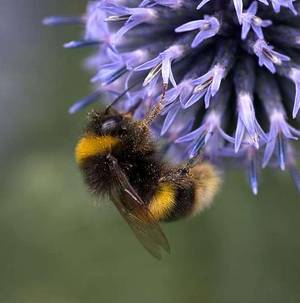Buzzing for flower fields
Interview with
A few years ago, the news wires were buzzing when researchers showed that flowers attract bumblebees using electrical signals, and that the bees can tell one bloom from another just on the basis of "flower power". But how do the bees do it? Emma Sackville caught up with the buzz from researcher Gregory Sutton...
flowers attract bumblebees using electrical signals, and that the bees can tell one bloom from another just on the basis of "flower power". But how do the bees do it? Emma Sackville caught up with the buzz from researcher Gregory Sutton...
Gregory - Bumble bees are magnificently fuzzy and this fuzz gives bumble bees a sensory ability to tell things about the world around them. It's not just for keeping them warm, and it's not just for measuring wind currents, it's also for measuring the electric fields of various plants and animals around them.
Emma - And how did you go about testing these hairs on the bees?
Gregory - There are two experiments we ran. The first is we put a hair in an electric field and used a device called a laser vibrometer to measures the hair's motion in the electric field. And we found that when you change an electric field, the hair moves back and forth and you can actually oscillate a hair using an electric field.
And then the second experiment is - you put a hair in an electric field and we were able to get very, very fine wires placed at the base of a hair. And those fine wires would tell us what the cells and other structures at the bottom of the hair were doing and you record the electrical activity in the nervous system to see if the motion of the hair causes an electrical signal to be sent back to the nervous system.
Emma - You mentioned that bees can detect these small electrical fields. What are the implications of this, if they can detect flowers, can they detect other electric fields?
Gregory - We don't see any reason why not. We found that they can tell the difference between different flowers, and we're currently working towards defining exactly the kind of electric field they can detect, and what electric fields affect them, and what electric fields don't.
Emma - So could electric fields that we produce cause any effect to them?
Gregory - That is a very careful question and I'm not comfortable answering that. Any answer I give to that question will make somebody angry. So I'm not comfortable answering that question until I have data that says specifically one way or the other.
Emma - Sure, OK. Bees can detect these fields because they're fuzzy - are a lot of other insects similarly fuzzy?
Gregory - There are many, many insects and spiders that are fuzzy. There are fuzzy moths, fuzzy butterflies, there's a couple of fuzzy crickets. The abdomen of a lot of spiders are fuzzy, which makes us suspect that there are many, many insects measuring electric fields in this way.
Emma - And what would other insects use the electric fields for?
Gregory - Well, the easiest thing is that we've found is that insects are actually electrically charged and they create their own electric fields. And if you had something that sensed electric fields, you would be able to detect the presence of another insect nearby. This would be no further than say 10 or 20cms but it would be a close way to tell if there were other insects nearby and because many insects eat other insects, this would be a great, great utility to all sorts of insects if they could do it.
Emma - Why is it important for us to know how bees detect flowers?
Gregory - In the pure scientific sense, everything that's known between bees and flowers is important for just agriculture and fruit. There are many, many fruits pollinated by bees. If we know how flowers and bees interact, we can actually create farms that are more friendly to bees and increase pollination levels. From a larger sense, this is branching into a field of electrostatic biology which, if we find this in many, many other insects, might be a whole realm of interactions that we might need to know in order to control or otherwise affect insects.
This was not the first paper over the last couple of years to show that the insects we deal with everyday are doing amazing things, and this will by no means be the last. And we know so little about what's going on in the insect world, and the guys we just encounter in the park, and just in the garden, and just on your windowsill. And that whole area of science, I think, is fascinating and it tells us about the world we live in and it's the things we see every day.










Comments
Add a comment